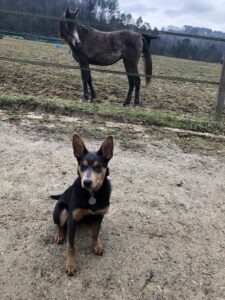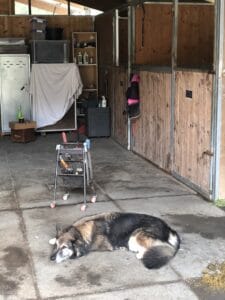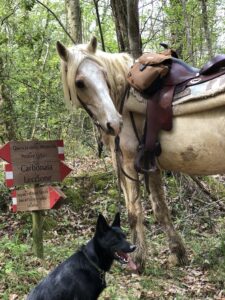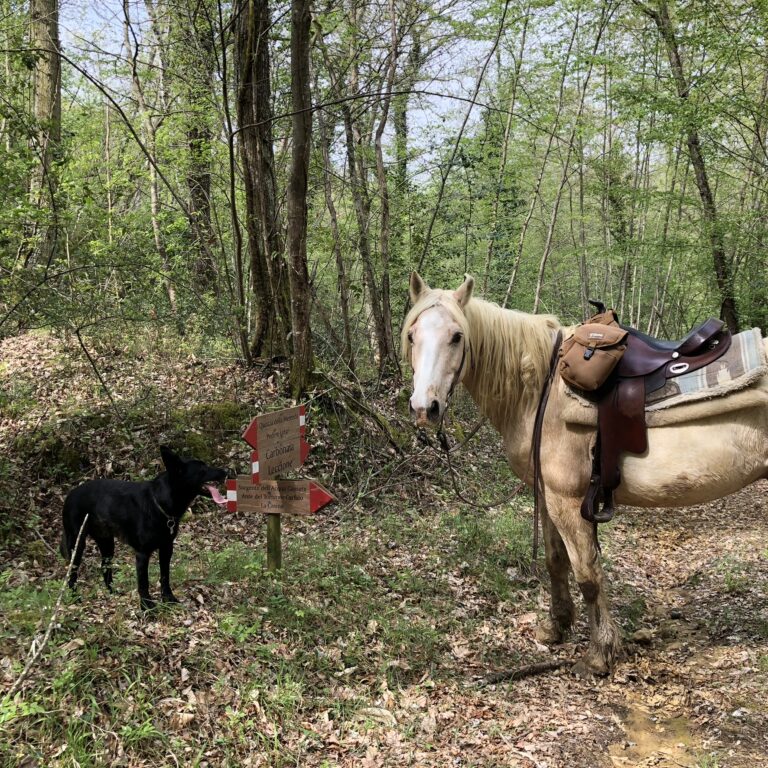Although dogs and horses have taken very different evolutionary paths, they have coexisted alongside humans for centuries due to domestication.
While most dogs can be trained to accept horses, there are some breeds that are better known for being more agreeable with horses than others. Some dogs are born with a natural affinity for being around horses, while others may take more time and training to adjust. Before you choose your next dog, it’s important to consider what exactly you expect from them too.
It’s important to consider various factors, including the size and personality each dog has. Tiny dogs’ risk being stepped-on or kicked, while large guardian breeds can become overly protective, scaring visitors and owners alike.
Some dogs which are trustworthy in closed environments (like the home) can react adversely to a rural setting, especially when they see horses running about. This sometimes encourages normally well-behaved dogs to exhibit unwanted behavior, like lunging, chasing or barking hysterically.
While some dogs do seem to have a special affinity for horses, almost any breed (or mix) can become accustomed to the presence of horses with care and training.
The most important traits are a calm and quiet manner around livestock, and the ability to respond to commands from their owner at all times.
Breeds that get along best with horses

Herding Dogs
Border collies, Old English Shepherds, Australian Cattle Dogs, Kelpies, Austalian Shepherds, Belgian Shepherds, Corgi’s, Shetland Sheepdogs, German Shepherds, Koolies, Huntaways.
Herding breeds were created to co-exist with livestock, making them a popular choice on farms that run horses. These dogs instinctively know how to avoid getting kicked or run over by horses, and with very little training they naturally show respect for livestock both at home, and out on rides. Because herding breeds are highly intelligent, and almost wolf-like in demeanor, they quickly learn what they are expected to do around the farm, and will thrive when given the chance to help out. They are especially loyal and attached to their humans and don’t need to be leashed all the time, which makes them often the most suitable to take riding out with you, since they stay close to the horses and don’t wander off.
Terrier Breeds
Jack Russel, West Highland Terriers, Fox Terriers, Staffordshire Terriers.
Mischievous and adventurous, terriers are popular with horse owners because they are small in size, and can easily fit in the horsebox, or beside their owner on the tractor during workhours. These feisty and energetic dogs are easy to clean up (if they do roll in the mud or manure pile) and usually have a friendly, affable nature that makes them popular with everyone they come into contact with. Terriers are also the most super-efficient breed for catching rats and mice, so they can also help out with pest control.
Gundogs
Labradors, Golden Retrievers, Pointers, Weimaraner, Spaniels, Setters
These breeds often have affectionate temperaments and friendly natures, making them the perfect breed for schmoozing with humans and horses alike. With proper training, hunting breeds can become excellent farm dogs, however, they can be tricky to take out on rides in areas where wildlife and game are present, as their instinct to hunt is stronger than following the group.
Non-Sporting Breeds
Poodle, Husky, Rottweiler, Dalmation, Shiba Inu, Shar Pei
Non-Sporting breeds have varying sizes, coats, personalities and overall appearance.These dogs need owners who are consistent and capable at training them as the are not naturally “good” with horses or other livestock (with the exception of Dalmatians, that were bred to accompany carriages). With consistent exposure and training, these breeds can learn to stay out from underfoot and not bother the horses.
Hounds
Beagles, Basset hounds, Salukis, Borzois, Bloodhounds, Foxhounds
Most hound breeds were bred to travel long distances with horses while hunting. While hounds can make wonderful companions at home, they can be problematic to keep off the leash. Their desire to follow their nose almost always proves stronger than their desire to listen to you. Hounds are prey-driven too, so any small, quick moving animal is seen as prey, and may be chased.

Basic Training for Horse Hounds
Regardless of the breed, your dog needs to be trained to behave appropriately around horses. Through slow and steady exposure, you can ensure that both your dog and your horse remain healthy, safe, and happy.
Keeping your dog on a lead initially is the best option for avoiding dangerous horse-dog encounters.
Even on a leash, your dog should have some basic training under his belt before he visits your horses habitat. Depending on the breed, training may mean overriding your dog’s natural chase instinct, and while this response is often a strong one, with a little practice, your dog can be taught to listen to you instead.
4 important commands to teach your dog before visiting your horses
- A really well entrenched ‘sit’ can be employed when introducing new people and animals and while you are riding.
- An effective ‘wait’ will stop a dog anywhere. This command will ask him to pause, reflect, and shift his attention back to you.
- ‘Leave it’ can be applied if your dog tries to chase horses, people or other dogs, or barks excessively. It can also be used to prevent him from eating leftover hoof clippings (which cause a sore tummy later on) or testing out the manure pile!
- A well-practised recall is crucial when you need to summon your dog and bring him back to you and under your control.
Top tip – A dog whistle carries better than your voice, and in a rural area where dogs can wander off to investigate fresh sights and smells, a whistle can be used as a potent back up to any of your voice commands.

How To Introduce Your Horse and Dog
Once your dog is listening to you and understands basic commands , you can introduce him to your horse. If you can, introduce your dog first to a horse that’s not scared of dogs.
If your horse isn’t used to being around with dogs, you can try to desensitize him to small animals moving around his legs by rolling a ball or roll of toilet paper under him first.
Some dogs may see horses as something to play with, so be especially careful of very small dogs or older dogs that may not hear or see as well. Take things slow and keep an eye out for signs of fear or over-arousal in either party.
For safety purposes, keep some distance between the horse and dog during the first encounters to make sure both parties are calm and comfortable and if your dog finds the experience of being around horses too overwhelming, consider bringing a crate, or use an empty stall to calm him down when he gets agitated.
Both are safer options than leaving him tied (where he risks being trodden on) or off the lead, where he may chase horses or get into trouble.



